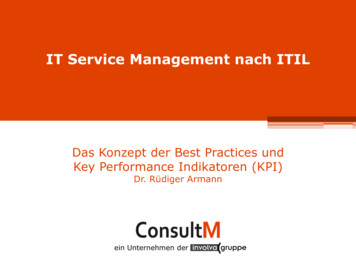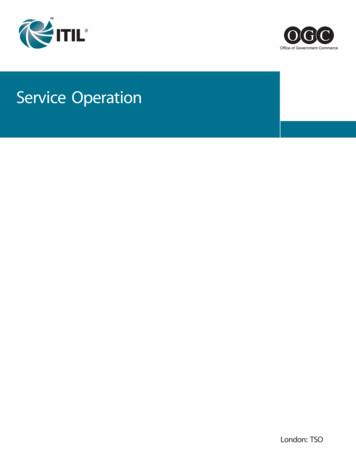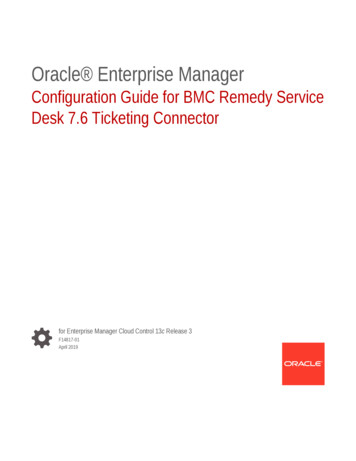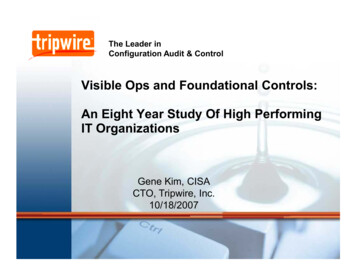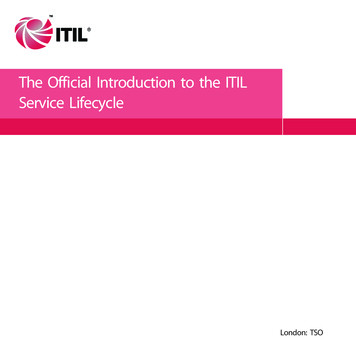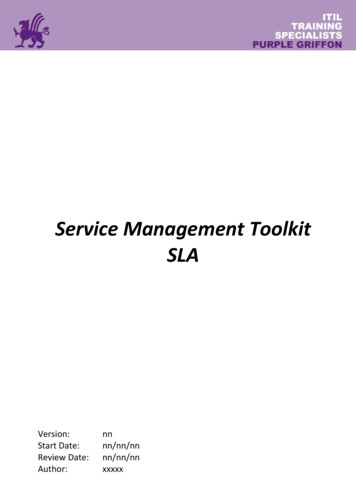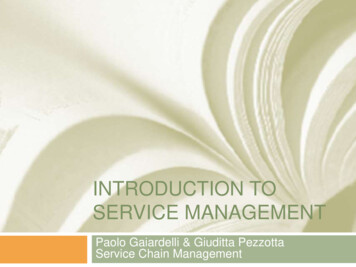
Transcription
INTRODUCTION TOSERVICE MANAGEMENTPaolo Gaiardelli & Giuditta PezzottaService Chain Management
Goal & alapplications, focusing on both thestrategic and operational aspectsthatcharacteriseServiceconfiguration and management,this course deals with Servicedesign, organization, managementand performance measurement. Introduction to Services The classification of services Service Engineering & Operations Service Capacity Service PerformanceMeasurement
Information3 Paolo Gaiardelli 035/2052046 paolo.gaiardelli@unibg.it Monday – 08.00-09.00 Giuditta Pezzotta 035/2052385 giuditta.pezzotta@unibg.it Monday – 16.30-18.30EXAM : Written Materials (on ILIAS) Slides Readings(mandatory) Further readings(optional)
Program4 May 04 (3h)- IntroductionMay 05 (2h)- Service classification modelsMay 11 (5h)- Service capacityMay 18 (5h)- Service EngineeringMay 25 (3h)- Service OperationsMay 26 (2h)- Service Operations – The ABB caseJune 08 (4h)- Service Performance Measurement
Exam5Written The written exam includes exercises and questions, based on all theService Management program (theory and mandatory papers). The oral exam is taken only upon a specific request of the candidate, orin case of a written evaluation between 15 and 18 The oral exam will consist of a discussion on topics presented in thiscourse.
Why services?6Gross value-added at basic prices, by branch of activityYear 2007 Unit of measure: Million 0 www.cia.gov]
Why services?7% of GDP from a.com, 2012]
Service: a definition8“Any activity or benefit that one party can offer to another that is essentiallyintangible and does not result in the ownership of anything”[Kotler, 1997]“A service is an activity or series of activities of a more or less intangiblenature that normally, but not necessarily, take place in interactions betweenthe customer and the service employees and/or physical resources or goodsand/or systems of the service provider, which are provided as solutions tocustomer problems”[Grönroos, 1990]
Typical service industries9 Transport and staurant and foodMass mediaHealthcare/hospitals/pharmacyInformation TechnologyWaste disposalBankingInsurance Financial servicesLegal servicesMarketing servicesResearch & ing / EntertainmentRetail sales / FranchisingReal estateEducation
Service Taxonomy10ServicesNon-Material servicesProduct Result (result-oriented)Product utility (use-oriented)Product extension (product-oriented)GoodsMaterial services[adapted from Bartolomeo et al., 2003]
The central notion of service11Variability / HeterogeneityServices are not standardised.The customer-providers interaction opens up possibilities of variationSimultaneity /InseparabilityPerishabilityThe realisation of a serviceimplies the presence ofprovider as well ascustomerServices can not be keptin stockIntangibilityThe result of a service is a process or an act
Implications of Intangibility12 Search qualitiesIntangibleCan be determined prior to purchase(such as colour, price, feel, smell) Experience qualityCan be discerned after the purchaseor during the consumption (taste) Credence qualityTangibleSearchExperienceCredenceCan be evaluated after the purchaseor on the basis of an achieved skillMarketing implications“make tangible the intangible”
Implications of Intangibility13“make tangible the intangible”Sight
Implications of Intangibility14“make tangible the intangible” Sound
Implications of Intangibility15“make tangible the intangible” Smell
Implications of Intangibility16“make tangible the intangible” Taste
Implications of Inseparability17Production and consumptionhappen at the same timeThe customer has to be presentwhere the service is providedServices are place dependentDirect interaction betweenservice provider and customerServices are humanrelationship dependentImplications of PerishabilityProduction and consumptionhappen at the same timeSupply and demand in service aredependent on capacitymanagement
Implications of rroundingsSERVICES PERFORMANCEDepends on service variability Service provider mood / skills Customer behaviour External factorsCustomer1. Adopt a strict servicequality monitoring2. Improve service process3. Introduce a risk analysis4. Work on employees skillsand competences
Services vs. goods19SERVICESGOODSAn activity or processA physical objectIntangibleTangibleSimultaneous production andconsumptionSeparation of production andconsumptionCustomers partecipate inproductionCustomers do not partecipate inproductionHeterogeneousHomogeneousPerishable: cannot be kept in stockCan be kept in stock
20Driving forces behind the growth ofservices The impact of income changes on buyingbehaviour Sociological and demographical changes The growing importance of producer services Technological developments
21Driving forces behind the growth ofservicesMaslow’s pyramid vs. serviceServicesDisposable IncomeGoods[Maslow, 1987]The impact of income changes on buying behaviourThe rise of disposable incomes has boosted the demand for both social andpersonal services (leisure, private health care, hotels, etc.)
22Driving forces behind the growth ofservicesSociological and demographical changesThe traditional family is being replaced by the duel-income family. The familyhas to outsource many activities to service providersThe increase in life expectancy, boosts demand for nursing homes, healthcare services and specialized travel agenciesThe increase of life complexity calls for the need of professional services likethe legal advisers or the income tax consultants
23Driving forces behind the growth ofservicesThe growing importance of producer services―Goods provision―Integrated solutions―Product-based organisations―Services (consulting, legal, accounting,R&D, transport, surveillance, cleaning)supporting complex organisation andbusiness models
The new manufacturing context24DeregulationInnovation of technologyGlobalisationIndustrialisation of emerging economiesFierce competitive pressureTo survive manufacturing firms canrarely remain as pure manufacturingfirms they have to move beyond manufacturingand offer services and solutions, deliveredthrough their products.
The servitization phenomenon25VideoServitization is the evolutionary phenomenon of the business model of amanufacturing company, moving from a product-centric perspective towardsProduct-Service Systems (PSSs), based on the provision of integrated bundlesconsisting of both physical goods and edVandermerwe, S. and Rada, J. (1988). Servitization of business: Adding value by addingservices. European Management Journal, 6 (4), 314-324.
No more Ford T26
27The servitization of manufacturing(by country)[Neely et al., 2011]
Some successful examples28FROMselling photocopiers TO being a“document company”FROMproducing explosives FROMselling aircraft engines TO providing “rock onthe ground” TO providingfunctionality(“Power by the hour”)[The Economist, 2009]
The expected benefits29What are the main reasons for offering product-support services?Customer loyalty84Differentiation73Support for the physical product55Economic objectives4840Other10 20 30 40 50 60 70Percentage ofrespondents
The expected benefits301. Economic rationale2. Profitability of services Stability of service revenues along the entire product lifecycleCompetitive rationale Differentiation Lock in customers and lock out competitors New customer needs3. Environmental rationale Dematerialization (functional economy)[Mathieu, 2001 (pp. 455-460)][Baines et al., 2009 (pp. 556-558)][Mont, 2002 (pp. 237-238)]
Economic rationale31IfM, 2004
The expected benefits32 Long-termmaintenanceGreen maintenanceHelp DeskSharing
Economic rationale33
Different Types of Value proposition34Service sophisticationOn Demand Manufacturing(e.g. takeover of production)Services to Enhance Customer Productivity(e.g. services to increase machine productivity)Services to Enhance Availability(e.g. SLA, Remote Services)Consulting Services(e.g. projection, financing, configuration)Basic Services(e.g. spare parts, maintenance, complaints, trainings)
35Driving forces behind the growth ofservicesTechnological developments
Servitization and technologySTRATEGY & CUSTOMER INTEGRATIONTechnology opens up new business opportunities to manufacturers through theintroduction of new business models characterised by a changed notion of assetownership and management.Ex: Car-sharing36
Servitization and technologySTRATEGY & CUSTOMER INTEGRATIONTechnology provides the opportunity todevelop a better understanding of customerbehaviours, easing the development of newProduct-Service (PS) solutions.Ex: Connection multi-channel37
Servitization and technologyIMPROVEMENT OFSERVICE PROVISIONPERFORMANCESProvides better asset operatingconditions, time in use, es, improving equipmentdesign and operation behaviourand reducing service deliverycosts.Ex: TELESERVICEEx: AUGMENTED REALITY38
Servitization and technologyOPERATIONS AND SERVICE CHAIN MANAGMENTBoosts value creation because it requires the redesignand the standardization of operating processes.Enables a comprehensive vertical and horizontalinformation sharing and coordination in all directionsbetween department, divisions and network partnerssupporting the implementation of the PS strategy.39
The future is «SMART» & «Social»40
Services ?4141
References42 Baines, T.S., Lightfoot, H., Benedettini, O., and Kay, J.M. (2009a). The servitization of manufacturing: A review of literature and reflection on futurechallenges. International Journal of Technology Management, 20 (5), 547-567. Bartolomeo, M., dal Maso, D., de Jong, P., Eder, P.,Groenewegen, P., and Hopkinson, P., et al. (2003). Ecoefficient producer services e what are they, howdo they benefit customers and the environment and how likely are they to develop and be extensively utilised? Journal of Cleaner Production, 11, 829-37. Fitzsimmons, J.A., Fitzsimmons, M.J. (2000). New Service Development: Creating Memorable Experiences. Thousand Oaks, CA: SAGE Publications Gebauer, H., Fleisch, E., and Friedli, T. (2005). Overcoming the Service Paradox in Manufacturing Companies. European Management Journal, 23(1), 14-26. Grönroos, C. (1990). Service Management and Marketing: Managing the moments of truth in service competition. Lexington: Lexington Books, p. 27. Kotler, P. (1997). Marketing Management : Analysis, planning, implementation and control. Englewood Cliffs, NJ: Prentice-Hall. Maslow, H. (1987). Motivation and Personality (Third edition). Harper & Row , Publishers Inc. Mathieu, V. (2001). Service strategies within the manufacturing sector: benefits, costs and partnership. International Journal of Service IndustryManagement, 12(5), 451-75. Mont, O. (2002). Clarifying the concept of product-service system. Journal of Cleaner Production, 10 (3), 237-245. Neely, A. (2009). Exploring the financial consequences of the servitization of manufacturing. Operations Management Research, 1 (2), 103-118. Neely, A.D., Benedettini, O. and Visnjic, I. (2011) ‘The Servitization of Manufacturing: Further Evidence’, 18th European Operations ManagementAssociation Conference, Cambridge, July 2011 turing.pdf The Economist, Rolls-Royce - Britain's lonely high-flier, Jan 8th 2009. Available at: http://www.economist.com/node/12887368 Vandermerwe, S. and Rada, J. (1988). Servitization of business: Adding value by adding services. European Management Journal, 6 (4), 314-324. Van Looy, B.V., Gemmel, P. and Van Dierdonck, R. (2003). Services Management: An Integrated Approach.Prantice Hall, Pearson Education Ltd.
Mandatory43 Vandermerwe, S. and Rada, J. (1988). Servitization of business: Addingvalue by adding services. European Management Journal, 6 (4), 314-324.
Motivation and Personality (Third edition). Harper & Row , Publishers Inc. Mathieu, V. (2001). Service strategies within the manufacturing sector: benefits, costs and partnership. International Journal of Service Industry Management, 12(5), 451-75. Mont, O. (2002). Clarifyin



